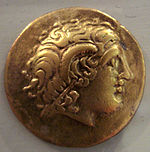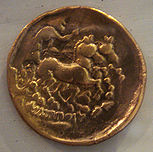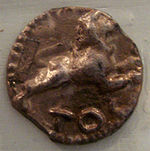- Sequani
-
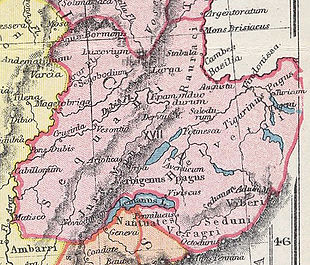 A portion of the map, Gallia, from Butler's 1907 atlas showing the divisions of the diocese of Gaul in the late Roman Empire.[1] According to the key, the map depicts 17 Provinciae Galliae, "Provinces of Gaul," of which the 17th, [Provincia] Maxima Sequanorum, "Greater Sequania," identified with an XVII shown in the Jura Mountains, contains the Sequani and Helvetii.
A portion of the map, Gallia, from Butler's 1907 atlas showing the divisions of the diocese of Gaul in the late Roman Empire.[1] According to the key, the map depicts 17 Provinciae Galliae, "Provinces of Gaul," of which the 17th, [Provincia] Maxima Sequanorum, "Greater Sequania," identified with an XVII shown in the Jura Mountains, contains the Sequani and Helvetii.
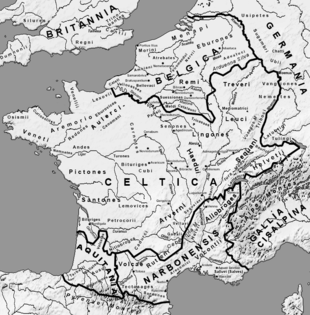 A map of Gaul in the 1st century BC, showing the locations of the Celtic tribes.
A map of Gaul in the 1st century BC, showing the locations of the Celtic tribes.
Sequani, in ancient geography, were a Gallic people who occupied the upper river basin of the Arar (Saône), the valley of the Doubs and the Jura Mountains, their territory corresponding to Franche-Comté and part of Burgundy.
Contents
Etymology
Sequani is an exonym assigned by the Romans, most likely based on a similar-sounding endonym. The endonym is not known for certain. Sequani is like Sequana, Caesar's name for the Seine, but the country of the Sequani is not in the Seine's watershed. Strabo was originally responsible for the folk-etymologic connection by supposing that the Sequana flowed through the country of the Sequani, a geographic error.[3] The French name of the Saône, however, the river forming the western border of the Sequani, derives from Celtic Souconna. The Romans called it the Arar. William Smith hypothesized that Sequani and Souconna were related.[4]
Geography
The country of the Sequani can be defined by the reports of the ancient writers.[4] The Jura Mountains separated the Sequani from the Helvetii on the east, but the mountains belonged to the Sequani, as the narrow pass between the Rhone and Lake Geneva was Sequanian.[5] They did not occupy the confluence of the Saône into the Rhone, as the Helvetii plundered the lands of the Aedui there.[6] Extending a line westward from the Jura estimates the southern border at about Mâcon, but Mâcon belonged to the Aedui.[7] Strabo says that the Arar separates the Sequani from the Aedui and the Lingones, which means that the Sequani were on the left, or eastern, bank of the Saône only.[8] On the northeast corner the country of the Sequani touched on the Rhine.[9]
History
Before the arrival of Julius Caesar in Gaul, the Sequani had taken the side of the Arverni against their rivals the Aedui and hired the Suebi under Ariovistus to cross the Rhine and help them (71 BC). Although his assistance enabled them to defeat the Aedui, the Sequani were worse off than before, for Ariovistus deprived them of a third of their territory and threatened to take another third, while subjugating them into semi-slavery.
The Sequani then appealed to Caesar, who drove back the Germanic tribesmen (58 BC), but at the same time obliged the Sequani to surrender all that they had gained from the Aedui. This so exasperated the Sequani that they joined in the revolt of Vercingetorix (52 BC) and shared in the defeat at Alesia. Under Augustus, the district known as Sequania formed part of Belgica. After the death of Vitellius (69 CE), the inhabitants refused to join the Gallic revolt against Rome instigated by Gaius Julius Civilis and Julius Sabinus, and drove back Sabinus, who had invaded their territory. A triumphal arch at Vesontio (Besançon), which in return for this service was made a colony, possibly commemorates this victory.
Diocletian added Helvetia, and part of Germania Superior to Sequania, which was now called Provincia Maxima Sequanorum, Vesontio receiving the title of Metropolis civitas Vesontiensium. Fifty years later, Gaul was overrun by the barbarians, and Vesontio sacked (355). Under Julian, it recovered some of its importance as a fortified town, and was able to withstand the attacks of the Vandals. Later, when Rome was no longer able to afford protection to the inhabitants of Gaul, the Sequani became merged in the newly formed Kingdom of Burgundy.
Major settlements
- Vesontio (Besançon)
- Luxovium (Luxeuil-les-Bains)
- Loposagium (Luxiol)
- Portus Abucini (Port-sur-Saône)
- Segobudium (Seveux)
- Epamanduodurum (Mandeure)
- Ariolica (Pontarlier)
- Magetobria / Admagetobria (Broye-lès-Pesmes)
- Pons Dubis (Pontoux)
- Castro Vesulio (Vesoul)
See also
Notes
- ^ Butler, Samuel; Rhys, Ernest (1907). "Map 4, Gallia". The Atlas of Ancient and Classical Geography. Everyman. London; New York: J.M. Dent; E.P. Dutton.
- ^ Boardman, John (1993). The Diffusion of Classical Art in Antiquity. Princeton: Princeton University Press. p. 308. ISBN 0691036802.
- ^ Strabo Geography, Book 4, Chapter 3, Section 2
- ^ a b Smith, William, ed (1873). "Sequana, Sequani". A Dictionary of Greek and Roman Geography. Volume II. London: John Murray. pp. 965–966.
- ^ Caesar BG, Book I, Section 6.
- ^ Caesar BG, Book I, Section 11.
- ^ Caesar BG, Book VII, Section 90
- ^ Strabo Geography, Book 4, Chapter 1, Section 11.
- ^ Caesar BG, Book I, Section 1.
Bibliography
- Caesar, Julius. De Bello Gallico.
- Strabo. Geography.
1911 Britannica References
- T. Rice Holmes, Caesar's Conquest of Gaul (1899), p. 483.
- A. Holder, Altceltischer Sprachschatz, ii. (1904).
- Mommsen, Hist. of Rome (Eng. trans.), bk. v. ch. vii.
- Dunod de Charnage, Hist. des Séquanois (1735)
- J. D. Schöpflin, Alsatia illustrata, i. (1751; French trans. by L. W. Ravenèz, 1849).
Celts Ancient Celts
Celtic studiesPlacesGaelic Ireland · Dálriata / Alba · Iron Age Britain / Roman Britain / Sub-Roman Britain ·
Iron Age Gaul / Roman Gaul · Galatia · Gallaecia · Britonia · Balkans · TransylvaniaReligionSociety
Modern Celts
Celtic RevivalLanguages Proto-Celtic · Insular Celtic (Brythonic · Goidelic) · Continental Celtic (Celtiberian · Gaulish · Galatian · Gallaecian · Lepontic · Noric)Festivals Lists Celts · Tribes · Deities · English words of Celtic origin · Spanish words of Celtic origin · Galician words of Celtic origin · French words of Gaulish originBelgica 

Celtica Abrincatui Aedui · Ambarri · Andes (Andecavi) · Arverni · Baiocasses · Bituriges Cubi · Cadurci · Caletes · Carnutes · Caturiges · Cenomani · Curiosolitae · Diablintes · Eburovices · Esuvii · Gabali · Helvetii · Lemovici · Lexovii · Lingones · Meldi · Namnetes · Nitiobriges · Osismii · Parisii · Petrocorii · Pictones · Redones · Ruteni · Santones · Senones · Segusiavi · Sequani · Tricasses · Turones · Unelli · Vellavi · Veneti · ViducassesAquitania Ausci · Boii · Convenae · Elusates · Lactorates · Tarbelli · Vasates · VivisciNarbonensis Allobroges · Arecomici · Cavares · Caturiges · Ceutrones · Deciates · Helvii · Nantuates · Salluvii · Volcae (Arecomici and Tectosages) · Tricastini · VocontiiPart of: Celtic tribes in Europe Late Roman Provinces (4th–7th centuries) History Provincial administration reformed and dioceses established by Diocletian, c. 293. Permanent praetorian prefectures established after the death of Constantine I. Empire permanently partitioned after 395. Exarchates of Ravenna and Africa established after 584. After massive territorial losses in the 7th century, the remaining provinces were superseded by the theme system in c. 640–660, although in Asia Minor and parts of Greece they survived under the latter until the early 9th century.Western Empire (395–476)Praetorian
Prefecture of GaulDiocese of Gaul: Alpes Poeninae et Graiae • Belgica I • Belgica II • Germania I • Germania II • Lugdunensis I • Lugdunensis II • Lugdunensis III • Lugdunensis IV • Maxima Sequanorum
Diocese of Vienne (later Septem Provinciae): Alpes Maritimae • Aquitanica I • Aquitanica II • Narbonensis I • Narbonensis II • Novempopulania • Viennensis
Diocese of Spain: Baetica • Balearica • Carthaginensis • Gallaecia • Lusitania • Mauretania Tingitana • Tarraconensis
Diocese of Britain: Britannia I • Britannia II • Flavia Caesariensis • Maxima Caesariensis • Valentia (369)Praetorian
Prefecture of ItalyDiocese of Suburbicarian Italy: Apulia et Calabria • Bruttia et Lucania • Campania • Corsica • Picenum Suburbicarium • Samnium • Sardinia • Sicilia • Tuscia et Umbria • Valeria
Diocese of Annonarian Italy: Alpes Cottiae • Flaminia et Picenum Annonarium • Liguria et Aemilia • Raetia I • Raetia II • Venetia et Istria
Diocese of Africa†: Africa proconsularis (Zeugitana) • Byzacena • Mauretania Caesariensis • Mauretania Sitifensis • Numidia Cirtensis • Numidia Militiana • Tripolitania
Diocese of Pannonia (later of Illyricum): Dalmatia • Noricum mediterraneum • Noricum ripense • Pannonia I • Pannonia II • Savia • Valeria ripensisEastern Empire (395–ca. 640)Praetorian
Prefecture of IllyricumPraetorian
Prefecture of the EastDiocese of Thrace: Europa • Haemimontus • Moesia II§ • Rhodope • Scythia§ • Thracia
Diocese of Asia*: Asia • Caria§ • Hellespontus • Insulae§ • Lycaonia (370) • Lycia • Lydia • Pamphylia • Pisidia • Phrygia Pacatiana • Phrygia Salutaria
Diocese of Pontus*: Armenia I* • Armenia II* • Armenia Maior* • Armenian Satrapies* • Armenia III (536) • Armenia IV (536) • Bithynia • Cappadocia I* • Cappadocia II* • Galatia I* • Galatia II Salutaris* • Helenopontus* • Honorias* • Paphlagonia* • Pontus Polemoniacus*
Diocese of the East: Arabia • Cilicia I • Cilicia II • Cyprus§ • Euphratensis • Isauria • Mesopotamia • Osroene • Palaestina I • Palaestina II • Palaestina III Salutaris • Phoenice • Phoenice Libanensis • Syria I • Syria II Salutaris • Theodorias (528)
Diocese of Egypt: Aegyptus I • Aegyptus II • Arcadia • Augustamnica I • Augustamnica II • Libya Superior • Libya Inferior • Thebais Superior • Thebais InferiorOther territories - affected (boundaries modified/abolished/renamed) by Justinian I's administrative reorganization in 534–536 † re-established after reconquest by the Eastern Empire in 534, as the separate prefecture of Africa § joined together into the Quaestura exercitus in 536
Categories:- Ancient peoples
- Auxilia palatina
- Sequani
- Tribes involved in the Gallic Wars
Wikimedia Foundation. 2010.

